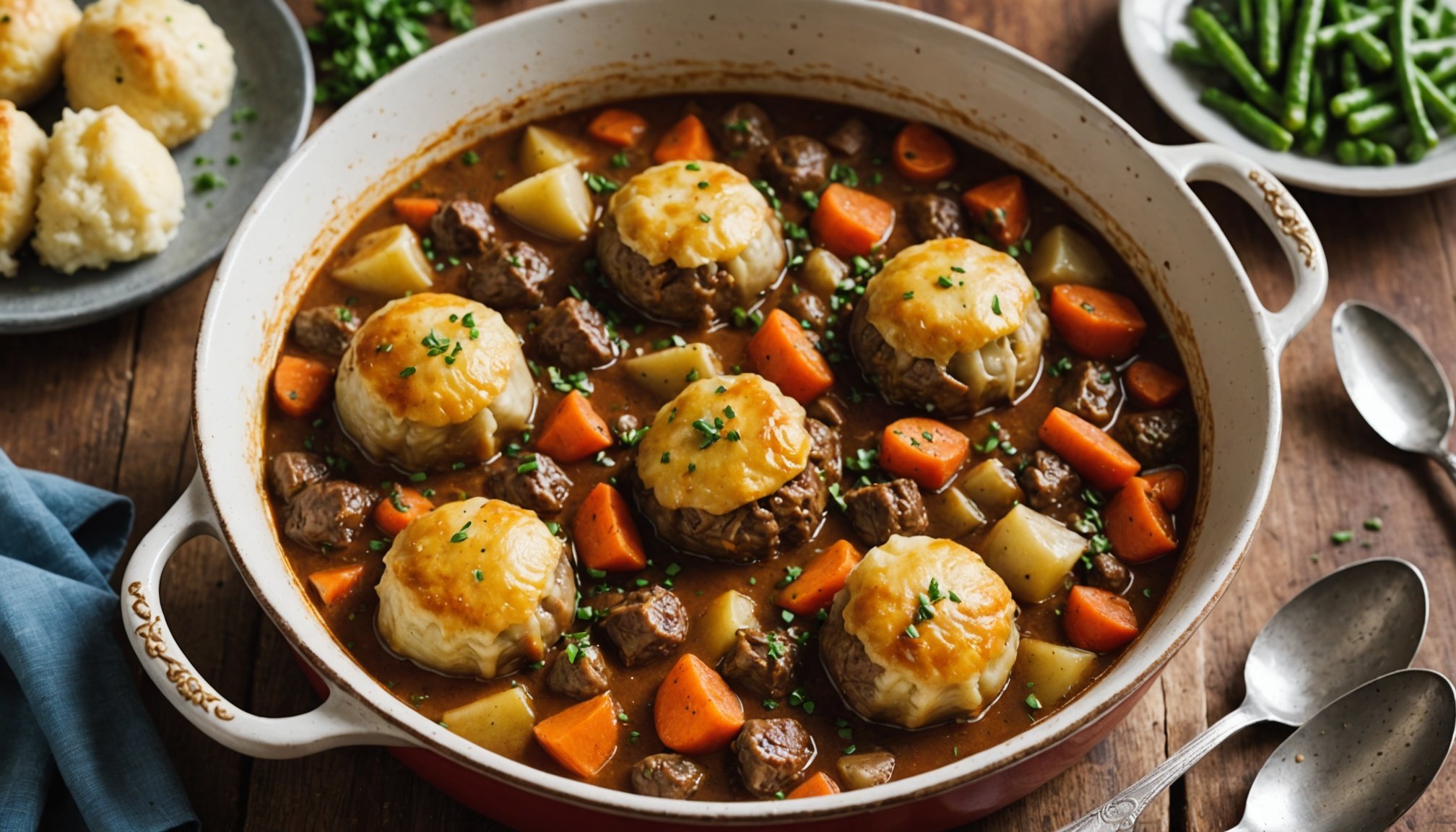Essential Ingredients for a Rich English Beef Stew
Creating a traditional beef stew requires careful selection of ingredients that build rich flavors and textures. The heart of any stew lies in its ingredients, each contributing significantly to the overall taste.
Choosing the right cut of beef is critical. For optimal flavor, choose cuts like chuck or braising steak. These cuts are marbled with fat and break down beautifully over a slow cook, ensuring tenderness and richness. As the beef slowly cooks, its flavors meld with the stew base, creating depth and complexity.
In parallel : Top strategies for handling toxic behaviors in online gaming communities
Fresh vegetables and herbs are equally essential. Vegetables like carrots, potatoes, and onions provide a hearty foundation, absorbing the beef’s juices. Seasonal herbs, such as thyme and bay leaves, introduce aromatic nuances that enhance the dish.
Traditional stew components include wine or beef stock to deglaze and enrich the flavors. The balance of these elements creates a warm, comforting dish perfect for any occasion. Employing a mix of traditional and fresh ingredients ensures the stew remains a timeless favourite. Emphasize quality in every ingredient for a memorable culinary experience.
Also to read : Unlock Pro Secrets for Creating the Creamiest English Rice Pudding Ever!
Step-by-Step Cooking Instructions
Creating an English beef stew involves a few key steps. Following these instructions will help you craft a dish rich in flavor and texture, perfect for any occasion.
Preparations before Cooking
Start with detailed prep. Ensure all ingredients are ready before you turn on the heat. Peel and chop fresh vegetables such as carrots, onions, and potatoes into uniform pieces for even cooking. Pat your selected cuts of beef dry with paper towels; this is crucial for better browning later.
Browning the Beef
Achieving the perfect browning creates a caramelized exterior that adds a delightful depth to your stew. Heat oil in a heavy-bottomed pot, then add beef in batches, avoiding overcrowding. Let each piece develop a golden-brown crust on all sides before removing it from the pot. This step is critical, as it locks in juices and enhances flavors.
Building the Stew Base
Begin with sautéing onions, which build the stew’s base flavours. Incorporate deglazing techniques using wine or stock to lift flavorful bits from the pot’s bottom. Layered flavours from the sautéed vegetables combine well with a beef or wine base, creating a traditional stew rich in taste and aroma.
Tips for Achieving Rich Flavor
Creating a memorable beef stew involves mastering the art of flavor enhancement. Precision in balancing seasoning not only adds depth and warmth, but also elevates the warmth of the dish. Start by seasoning layers rather than solely adding salt at the end. Incorporate a combination of salt, pepper, and herbs like thyme, bay leaves, or rosemary right from the initial sauté.
To deepen umami, consider ingredients rich in glutamates such as mushrooms or tomato paste. These enhance the beefiness and harmonize with the traditional stew components, creating a savoury backdrop. Umami’s contribution to the stew’s richness shouldn’t be underestimated.
Simmering time is crucial for complete flavor infusion. Allowing the stew to simmer slowly for an extended period enables all ingredients to blend harmoniously. A slow simmer not only tenderizes the meat but also melds the complex flavors of the herbs, stock, and wine into the beef and vegetables.
By patiently refining these culinary techniques, you ensure your English beef stew is a comforting and flavorful masterpiece.
Making Cloud-Like Dumplings
Creating lightweight dumplings involves a few simple techniques to achieve that cloud-like texture. Understanding each step is crucial, as it ensures your dumplings complement the beef stew perfectly.
Gathering Dumpling Ingredients
Start by assembling the necessary ingredients: flour, baking powder, salt, butter, and milk. These form the foundation of the dumplings’ texture. The balance of dry and wet ingredients is key; it determines the dough’s consistency, ensuring the dumplings remain tender and light.
Mixing Techniques for Fluffiness
The secret to fluffy dumplings lies in incorporating air. Use a gentle hand when mixing the dough. Avoid overworking it to prevent the dumplings from becoming dense. Combine the dry ingredients first, then gradually add milk and melted butter, folding them in until just combined. This technique traps air pockets, resulting in a pillow-soft outcome.
Cooking Methods for Dumplings
There are two primary methods to choose from: boiling or steaming. Boiling dumplings directly in the stew allows them to absorb some of the stew’s rich flavors. Steaming, on the other hand, keeps the dumplings lighter and separate from the liquid. Both methods offer delicious results, depending on your personal preference.
Serving Suggestions and Variations
Enhance your beef stew experience with the perfect accompaniments. Classic serving ideas include hearty sides like crusty bread or creamy mashed potatoes, which can soak up the flavorful sauce. For a lighter alternative, consider a fresh green salad to balance the richness of the stew.
Beef stew variations offer flexibility for different dietary preferences. For those avoiding red meat, substitute beef with chicken thighs or a meat-free option like mushrooms, which provide a similar umami depth. Vegetarians can enhance the stew with lentils or beans for protein, maintaining a filling and satisfying dish.
Transform your stew’s presentation with creative styles that impress. Serve it in a hollowed-out bread bowl for a rustic touch or in individual ramekins for an elegant meal. Garnishing with freshly chopped parsley or chives adds a pop of colour and freshness to the finished dish.
Engaging with these serving ideas and adaptations allows you to tailor the stew to any preference, ensuring it remains a versatile and beloved culinary delight. Explore these options to elevate your stew experience.
Visual Aids and Cooking Times
Enhance your cooking experience with visual aids and precise timing. Understanding each step is easier with images that clearly demonstrate the process. These guides ensure every cook, novice or experienced, confidently prepares their beef stew.
Incorporate step-by-step images to not only highlight techniques but also to showcase the desired outcome at each stage. Seeing how the perfectly browned beef or cloud-like dumplings appear can offer reassurance and reduce errors.
Suggested Cooking Times
Mapping out the recommended cooking duration is crucial for achieving consistent results. Browning the beef should take approximately 5-7 minutes per batch, ensuring a rich, caramelized surface. Allow the stew to simmer for at least 1.5 to 2 hours. This duration is critical for the infusion of flavours and tenderizing the meat.
Visual Representation
A visual representation of the final dish alongside suggested serving styles creates a complete image of what to aim for. Consider featuring an image of the stew served in a rustic bread bowl or alongside creamy mashed potatoes to stimulate culinary creativity. By engaging with these visual and timing tools, your stew can consistently turn into a delightful, warming dish.





